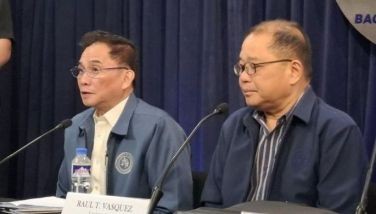Burning of rice straw, agri waste threatens the environment
July 30, 2006 | 12:00am
The common practice in the countryside of burning of rice straws and other agricultural wastes in preparation for the next planting season contributes more to air pollution than vehicle emissions.
This was the finding of the Department of Science and Technology (DOST) in its First National Inventory of Dioxins and Furans, which calculates and estimates the dioxin and furan releases using a method developed by the United Nations Environment Programme (UNEP).
DOST said uncontrolled open burning, mainly burning of agricultural wastes, is the highest source of carcinogenic dioxin and furans, the known environmental contaminants that are emitted during the combustion process. The high level of dioxins and furans releases was due to the low temperature and uncontrolled combustion of agricultural residues.
Also contributing to the high release of environmental contaminants is the slash and burn farming known as kaingin. In 2004, the National Statistical Coordination Board estimated that 11 hectares of land and an estimated 473 tons of material were burned because of kaingin.
Based on estimates by the Industrial Technology Development Institute (ITDI) of DOST, 250 kg of rice straw and 100 kg of rice hull are burned per ton of rice produced. This comes to a total of 5,073,880 tons of rice straw and rice hull burned every year. This contributed to the dioxin and furan releases to air and land of about 187.0457 g TEQ/a compared to the estimated emissions by transport sector of about 0.12 g TEQ/a.
The post harvest burning has not only posed threat to the environment but also to the health of the farmers. Various cases of road accidents recorded were due to the poor visibility caused by the smoke from the burning rice straws alongside the roads.
To help address this issue, Bayer CropScience has focused on raising farmers’ awareness of the ill-effects of rice straw burning to the environment under its sustainable agriculture project called BIGAS. The BIGAS project started in September 2005, in partnership with Asia Pacific Roundtable for Sustainable Consumption and Production, the Deutsche Investitions und Entwicklungsgesellschaft mbH and the Philippine Rice Research Institute.
Bayer CropScience plant and public affairs manager Tess Cayton said "the advocacy against rice straw burning has brought Bayer’s BIGAS project to provinces like Nueva Ecija and Iloilo. We educate and train the farmers’ cooperatives about the environment-friendly and useful alternatives to rice straw burning, in addition to helping them increase their yields through a Bayer CropScience package of technology that includes use of hybrid rice and integrated crop management."
Among the alternatives are on-site soil composting of rice straw with the use of effective micro-organisms to make organic fertilizer, and the use of rice straw and rice hull as fuel for cooking stove and as raw material for specialty papers.
Bayer’s BIGAS project was presented and showcased in various business and industry gatherings. Just recently, the Department of Environment and Natural Resources invited experts from Bayer CropScience to discuss the impact of the rice straw burning in a technical forum.
Bayer’s advocacy also got a big lift from the Department of Agriculture (DA) as it launched a nationwide campaign against rice straw burning, dubbed "Huwag Sunugin ang Dayami" with emphasis on improving soil fertility.
This was the finding of the Department of Science and Technology (DOST) in its First National Inventory of Dioxins and Furans, which calculates and estimates the dioxin and furan releases using a method developed by the United Nations Environment Programme (UNEP).
DOST said uncontrolled open burning, mainly burning of agricultural wastes, is the highest source of carcinogenic dioxin and furans, the known environmental contaminants that are emitted during the combustion process. The high level of dioxins and furans releases was due to the low temperature and uncontrolled combustion of agricultural residues.
Also contributing to the high release of environmental contaminants is the slash and burn farming known as kaingin. In 2004, the National Statistical Coordination Board estimated that 11 hectares of land and an estimated 473 tons of material were burned because of kaingin.
Based on estimates by the Industrial Technology Development Institute (ITDI) of DOST, 250 kg of rice straw and 100 kg of rice hull are burned per ton of rice produced. This comes to a total of 5,073,880 tons of rice straw and rice hull burned every year. This contributed to the dioxin and furan releases to air and land of about 187.0457 g TEQ/a compared to the estimated emissions by transport sector of about 0.12 g TEQ/a.
The post harvest burning has not only posed threat to the environment but also to the health of the farmers. Various cases of road accidents recorded were due to the poor visibility caused by the smoke from the burning rice straws alongside the roads.
To help address this issue, Bayer CropScience has focused on raising farmers’ awareness of the ill-effects of rice straw burning to the environment under its sustainable agriculture project called BIGAS. The BIGAS project started in September 2005, in partnership with Asia Pacific Roundtable for Sustainable Consumption and Production, the Deutsche Investitions und Entwicklungsgesellschaft mbH and the Philippine Rice Research Institute.
Bayer CropScience plant and public affairs manager Tess Cayton said "the advocacy against rice straw burning has brought Bayer’s BIGAS project to provinces like Nueva Ecija and Iloilo. We educate and train the farmers’ cooperatives about the environment-friendly and useful alternatives to rice straw burning, in addition to helping them increase their yields through a Bayer CropScience package of technology that includes use of hybrid rice and integrated crop management."
Among the alternatives are on-site soil composting of rice straw with the use of effective micro-organisms to make organic fertilizer, and the use of rice straw and rice hull as fuel for cooking stove and as raw material for specialty papers.
Bayer’s BIGAS project was presented and showcased in various business and industry gatherings. Just recently, the Department of Environment and Natural Resources invited experts from Bayer CropScience to discuss the impact of the rice straw burning in a technical forum.
Bayer’s advocacy also got a big lift from the Department of Agriculture (DA) as it launched a nationwide campaign against rice straw burning, dubbed "Huwag Sunugin ang Dayami" with emphasis on improving soil fertility.
BrandSpace Articles
<
>
- Latest
Latest
Latest
May 14, 2024 - 3:43pm
By Ian Laqui | May 14, 2024 - 3:43pm
April 10, 2024 - 5:12pm
By Ian Laqui | April 10, 2024 - 5:12pm
March 4, 2024 - 3:32pm
By Ian Laqui | March 4, 2024 - 3:32pm
March 4, 2024 - 2:12pm
By Kristine Daguno-Bersamina | March 4, 2024 - 2:12pm
February 17, 2024 - 2:31pm
February 17, 2024 - 2:31pm
Recommended





























